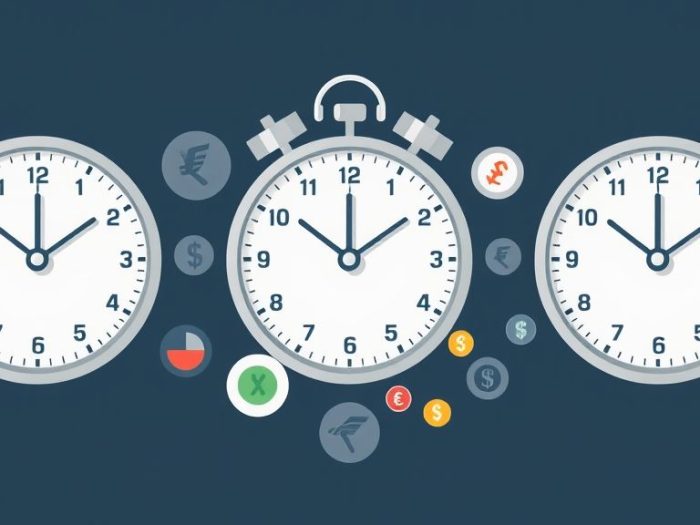Forex trading is a 24-hour market, but not all hours are created equal. Trading
during specific times can significantly impact your trading experience and
profitability. This article explores the best times to trade forex for maximum
liquidity and price movement, helping you optimize your trading schedule.
Understanding Forex Market Sessions
The forex market is divided into four major trading sessions:
- Sydney Session: The first to open, it’s generally the quietest.
-
Tokyo Session: More active than Sydney, with focus on Asian
currencies. -
London Session: The most active session, with significant
volatility and volume. -
New York Session: High volume, particularly during the overlap with
London.
Why Timing Matters in Forex
Trading volume and volatility vary significantly between sessions. Trading during
peak times offers:
-
Higher Liquidity: Easier to enter and exit trades at desired
prices. - Tighter Spreads: Lower transaction costs.
-
Increased Volatility: More price movement, offering more trading
opportunities.
Best Times to Trade Forex
1. London Session Open (08:00 – 12:00 GMT)
The start of the London session is often the most active time, as traders react to
overnight news and establish positions for the European trading day.
-
Why it’s good: High volume, volatility, and participation from
major financial institutions. - Pairs to focus on: EUR/USD, GBP/USD, EUR/GBP.
2. London/New York Overlap (12:00 – 16:00 GMT)
The overlap between the London and New York sessions is another period of intense
activity.
-
Why it’s good: Maximum liquidity and volatility, as major
economic data releases from both regions can impact the market. - Pairs to focus on: EUR/USD, GBP/USD, USD/JPY, USD/CHF.
3. New York Session Open (13:00 – 17:00 GMT)
The beginning of the New York session also sees increased activity, though it may
be less volatile than the London/New York overlap.
-
Why it’s good: Decent liquidity and movement, especially for
USD-related pairs. - Pairs to focus on: USD/JPY, USD/CAD, USD/CHF.
Times to Avoid
-
Asian Session: Generally low volatility and liquidity, unless
trading Asian currencies. -
Friday Afternoons: Liquidity tends to dry up as traders close
positions before the weekend. - Holidays: Market activity is significantly reduced on holidays.
Important Considerations
- Your Time Zone: Adjust the GMT times to your local time zone.
-
Trading Style: The best times may vary slightly depending on your
trading style (e.g., scalping, swing trading). -
News Events: Pay attention to economic calendars for upcoming news
releases, as they can cause significant volatility. -
Currency Pair: Different pairs may have different peak activity
times.
Conclusion
Trading during the London session open and the London/New York overlap generally
offers the best conditions for forex trading due to high liquidity and volatility.
However, consider your time zone, trading style, and be aware of news events to
optimize your trading schedule.
Related Keywords
Best time to trade forex, forex trading hours, forex market sessions, London
session, New York session, forex liquidity, forex volatility, forex trading
schedule, forex trading time, when to trade forex.
Frequently Asked Questions (FAQ)
1. What are the major forex trading sessions?
The major forex trading sessions are Sydney, Tokyo, London, and New York.
2. Why does timing matter in forex trading?
Timing matters because trading volume and volatility vary significantly between
sessions, affecting liquidity and spreads.
3. Which forex session is generally the most active?
The London session is generally the most active, followed by the New York
session.
4. What is the best time to trade forex?
The best times to trade are generally during the London session open (08:00 –
12:00 GMT) and the London/New York overlap (12:00 – 16:00 GMT).
5. Why is the London/New York overlap so active?
The London/New York overlap has maximum liquidity and volatility due to
participation from traders in both regions and potential economic data
releases.
6. What currency pairs are most active during the London session?
EUR/USD, GBP/USD, and EUR/GBP are typically active during the London session.
7. What currency pairs are most active during the New York session?
USD/JPY, USD/CAD, and USD/CHF are typically active during the New York
session.
8. What forex session is generally the quietest?
The Asian session is generally the quietest with lower volatility and
liquidity.
9. Should I avoid trading on Friday afternoons?
Yes, liquidity tends to dry up on Friday afternoons as traders close
positions before the weekend, which can lead to unpredictable price
movements.
10. How do news events affect forex trading times?
News releases, especially economic data, can cause significant volatility,
so it’s important to be aware of the economic calendar.



